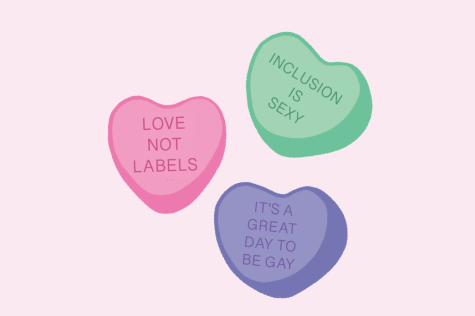Valentine’s Day: The exclusivity of Cupid’s club
February 10, 2021

As New Years’ celebrations come to an end, reservations at restaurants across the world begin being made for Feb. 14, otherwise known as Valentine’s Day. This holiday is typically defined by the exchanging of chocolates, flowers, jewelry and other romantic gifts between couples to commemorate and celebrate their love. Whether you anticipate Valentine’s Day with passion and excitement or dread and irritation, the traditions of this holiday have maintained a consistent presence amidst centuries of ever-evolving culture.
Although today we share a fairly uniform understanding of what Valentine’s Day represents, various origin stories of the holiday have been proposed over time, casting mystery onto its history. Many people know Valentine’s Day as the feast day of St. Valentine, the Christian martyr memorialized in stories as a sympathetic, heroic and romantic figure. While many believe that this holiday is celebrated in the middle of February to commemorate the anniversary of Valentine’s death or burial in accordance with Christian teaching, others claim that the Christian church may have decided to use this as a distraction from the pagan celebration of Lupercalia. Celebrated on Feb. 15, Lupercalia was a festival with unknown origins that involved a feast and a ritual sacrifice. Lupercalia was outlawed at the end of the fifth century, when Pope Gelasius declared Feb. 14 St. Valentine’s Day, but it was not until the Middle Ages that the day became definitively associated with love and romance. During the Middle Ages, it was a common European belief that Feb. 14 was the beginning of birds’ mating season, which might have been yet another inspiration for the first official record of St. Valentine’s Day being viewed as a day of romantic celebration by the English poet Geoffrey Chaucer in his 1375 poem “Parliament of Foules.”
Regardless of which origin story is true or which one you choose to believe, the one element of Valentine’s Day that remains consistent is its heteronormative assumptions. Like most things in the U.S., Valentine’s Day was quickly recognized by capitalist industries as another way to generate mass profit, and the holiday slipped into commercialized culture. Heteronormative marketing defined the capitalist seizure of Valentine’s Day. Gift cards depicted straight, cisgender couples, “his and hers” labels covered the isles of stores and advertisements featured heterosexual couples. Money-hungry corporations used this holiday as an opportunity to exploit American consumer culture by reinforcing the gender binary and representing only the monogamous heterosexual relationship dynamic.
Not only does the capitalist manipulation of Valentine’s day exclude the queer population from the narrative, but the holiday itself operates under the assumption that all those involved in a romantic relationship have the privilege of freely celebrating their love in the public domain. Queer couples often face fears of physical, verbal or emotional abuse from other members of society if they choose to engage in romantic activities in public. The awkward, but often necessary, conversation explaining to the waitress that you are not just two best friends and will be paying on one ticket, the chance that a floral company or restaurant will deny your requests because of your sexuality or gender identity or the lack of representation that you feel invalidates your love are all realities in the world of queer Valentine’s Day.
While significant progress has been made in the representation and protection of the LGBTQ community, the exclusivity of Valentine’s Day reminds us that there is still a great deal of progress left to make for this community to be able to celebrate their love as freely and proudly as heterosexual, cisgender couples. It is important to remember that the legacy of same-sex marriage, which was legalized less than a decade ago in the U.S., is competing against a history of centuries of violent and persistent anti-LGBTQ culture that has permeated society and holidays like Valentine’s Day. Celebrating Valentine’s Day and the love that you share with someone can be a wonderful thing, but you can support LGBTQ love in doing this as well. Instead of going to Hallmark or Walmart to get your gifts and flowers, browse the internet for local queer-owned businesses. Be mindful of the implicit perceptions you have about what celebrating Valentine’s Day looks like. Spread awareness of problems such as these to create more inclusive, more realistic, more beautiful Valentine’s Day experiences.









Jake • Feb 13, 2021 at 3:17 pm
Keep the “Saint” in St. Valentine’s Day.